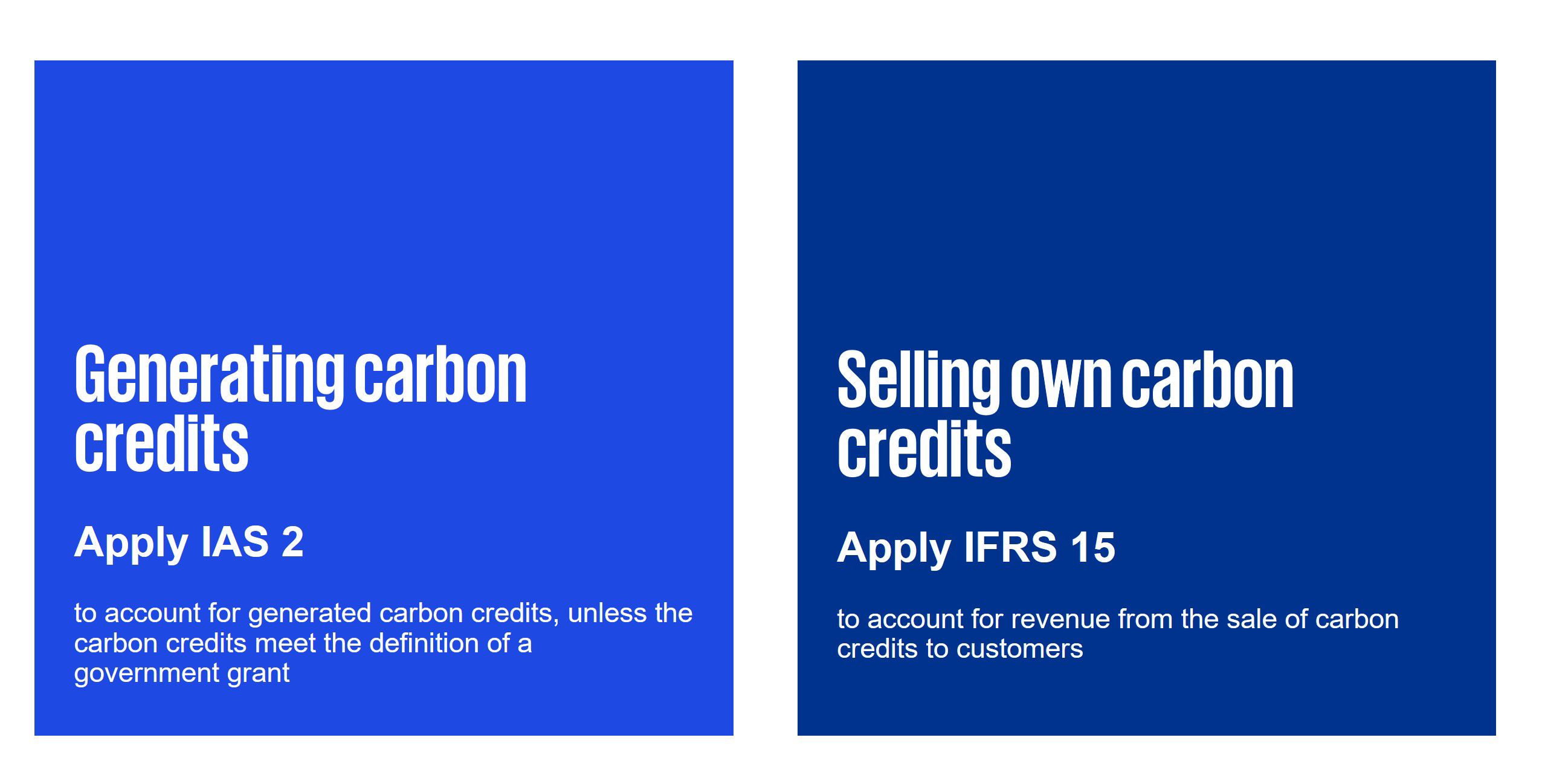Green initiatives vary greatly. Some initiatives are aimed at reducing emissions of CO2 – e.g. by using sustainable fuels or greener inputs into the production process. Other initiatives are aimed at removing CO2 from the atmosphere – e.g. by planting trees. As part of many green initiatives, companies can generate carbon credits. A company undertaking a green initiative and generating carbon credits for sale in the ordinary course of business generally applies the following accounting standards.

Some green initiatives have a relatively long life cycle – i.e. from the date a company starts incurring costs until the date the credits are registered and can be sold to third parties. Therefore, a company needs to apply judgement to determine when to recognise carbon credits as inventory.
IAS 2 does not provide specific guidance on the timing of recognition of inventory. In our view, in the absence of specific guidance in IFRS® Accounting Standards and considering the intangible nature of carbon credits, in making a judgement about when to start capitalising costs in such cases, a company may apply – by analogy – the guidance in IAS 38 for internally generated intangible assets. This guidance distinguishes between a research phase and a development phase, and specifies recognition criteria. [IAS 8.11(a), 38.52]
The cost includes all direct costs (e.g. labour, material and direct overheads) and an allocation of fixed and variable overheads.
In some cases, determining the cost of generated carbon credits will be straightforward. For example, if a company plants trees solely to generate carbon credits and the trees are accounted for as property, plant and equipment under IAS 16, then the cost of these carbon credits will include depreciation on the trees (as well as any other qualifying costs mentioned above).
Other cases will be more complex (see Question 3).
Yes, but only in limited circumstances. For example, a company has an existing forest which is cultivated for timber and accounted for under IAS 41 at fair value less costs to sell. Under a new green initiative, it then also registers a project to generate carbon credits by the same forest, which will continue to be cultivated for timber and accounted for under IAS 41.
The fair value of the trees – before recognition of carbon credits as a separate asset – would typically reflect the fair value of both the timber and the carbon credits. In our view, in this scenario a company may determine the cost of generated carbon credits based on their fair value less costs to sell – which was reflected in the fair value of the trees at the date on which the carbon credits are recognised as inventory. This approach is similar to measuring agricultural produce at fair value less costs to sell when it is recognised as inventory.
No. Only broker-traders can measure their inventories at fair value less costs to sell.
In our experience, companies undertaking green initiatives generally do not act as broker-traders for the carbon credits they generate because they do not buy those credits, but instead ‘produce’ them.
Under some green initiatives, a company may use green inputs in producing goods or delivering services and generate carbon credits that can be sold separately – e.g. an airline may generate carbon credits by using sustainable aviation fuel for its flights and sell them separately from the underlying transportation services.
In our view, if carbon credits are generated in the process of producing another good or delivering a service, then it is generally appropriate to determine their cost based on the relative sales value of the carbon credits and the other good or service, unless the sales value of these goods or services is highly variable or uncertain. In such cases, we believe that it may be acceptable to use another approach that would result in an allocation of the cost on a rational and consistent basis. [IAS 2.14, IFRS 15.79(c)]
Under some green initiatives (unlike those discussed in Question 5), a company uses green inputs in producing goods or delivering services and generates green attributes that cannot be sold separately – e.g. by using a mix of more expensive sustainable inputs and less expensive fossil-based inputs, it can label a portion of its interchangeable output as green.
In such cases, although the use of green inputs increases overall production costs, no identifiable benefit is transferred to the customer separately from the finished goods. Therefore in our view, a green attribute that cannot be transferred to a customer separately from a finished good forms part of the cost of the inventories produced, and cannot be accounted for separately. [IAS 2.10]
Yes, in some cases. Some green initiatives may form part of a set of government measures, under which carbon credits generated by green initiatives could be used to offset emissions obligations under mandatory emissions schemes in the same jurisdiction.
Judgement may be required to determine if such carbon credits meet the definition of a government grant under IAS 20 from the perspective of the company generating them, including:
- whether there is a transfer of resources from the government;
- the extent of the government’s involvement in the scheme – e.g. if the government requires polluting companies to purchase carbon credits generated by the green initiative; and
- the ability to distinguish the receipt of the carbon credits from the normal trading transactions of the company.
A company undertaking a green initiative and generating carbon credits applies the requirements in IFRS 15 to account for revenue from the sale of carbon credits to customers. The analysis may be straightforward if a company sells carbon credits separately from any other goods or services.
Conversely, if carbon credits are transferred to the customer together with other goods or services, then the company needs to determine whether carbon credits are distinct and represent a separate performance obligation under the contract (see Question 9).
A company needs to consider the nature of the promise to the customer and how the customer can benefit from it – i.e. whether it transfers greener goods or services, or transfers goods or services plus a separate carbon credit.
In our view, these considerations may be helpful in performing the analysis and determining whether carbon credits represent a separate performance obligation in a contract with a customer.
This page references specific IFRS® Accounting Standards – see our glossary for the full list of standards.
© 2025 KPMG IFRG Limited, a UK company, limited by guarantee. All rights reserved.
Explore
Connect with us
- Find office locations kpmg.findOfficeLocations
- kpmg.emailUs
- Social media @ KPMG kpmg.socialMedia



